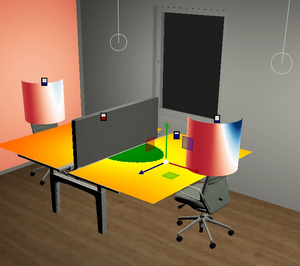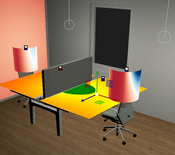Information
- Publication Type: Bachelor Thesis
- Workgroup(s)/Project(s):
- Date: September 2022
- Date (Start): 5. August 2021
- Date (End): 30. September 2022
- Matrikelnummer: e11778912
- First Supervisor: Michael Wimmer
Abstract
The human visual system allows us to perceive our environment by processing incoming light. This visual system enables us to make decisions based on the information or objects we see. Many tasks in our daily life require us to see our surroundings. Depending on the task, a well-illuminated environment will be beneficial to accomplish the given task. To properly design lighting environments, computer applications are used to simulate the distribution of light and test if the results meet the predefined requirements. The current workflow of state-of-the-art applications is sequential, where the user first plans a scene and then triggers the lighting simulation. The problem with this approach is that the user will have no insight into the resulting lighting conditions until the simulation has finished. Planning a lighting environment is an iterative process, where the user iteratively changes the scene till the plan meets the requirements. Reducing the time per iteration will also reduce the overall planning time and increase the planner’s productivity. This thesis presents a novel workflow by providing the user with intermediate results of the computed lighting conditions in the planning phase. We believe that this approach will help the user to plan lighting environments faster and more intuitively.Additional Files and Images
Weblinks
No further information available.BibTeX
@bachelorsthesis{landauer-2022-kido,
title = "Kido: a hardware-accelerated lighting planning software",
author = "Michael Landauer",
year = "2022",
abstract = "The human visual system allows us to perceive our
environment by processing incoming light. This visual system
enables us to make decisions based on the information or
objects we see. Many tasks in our daily life require us to
see our surroundings. Depending on the task, a
well-illuminated environment will be beneficial to
accomplish the given task. To properly design lighting
environments, computer applications are used to simulate the
distribution of light and test if the results meet the
predefined requirements. The current workflow of
state-of-the-art applications is sequential, where the user
first plans a scene and then triggers the lighting
simulation. The problem with this approach is that the user
will have no insight into the resulting lighting conditions
until the simulation has finished. Planning a lighting
environment is an iterative process, where the user
iteratively changes the scene till the plan meets the
requirements. Reducing the time per iteration will also
reduce the overall planning time and increase the
planner’s productivity. This thesis presents a novel
workflow by providing the user with intermediate results of
the computed lighting conditions in the planning phase. We
believe that this approach will help the user to plan
lighting environments faster and more intuitively.",
month = sep,
address = "Favoritenstrasse 9-11/E193-02, A-1040 Vienna, Austria",
school = "Research Unit of Computer Graphics, Institute of Visual
Computing and Human-Centered Technology, Faculty of
Informatics, TU Wien ",
URL = "https://www.cg.tuwien.ac.at/research/publications/2022/landauer-2022-kido/",
}

 thesis
thesis

